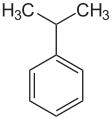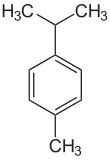Alkylbenzenes
The alkylbenzenes are derivatives of , in which one or more hydrogen atoms are replaced by alkyl groups of different sizes. They are a subset of the aromatic hydrocarbons. The simplest member is toluene, in which a hydrogen atom of the benzene was replaced by a methyl group.
| Examples of alkylbenzenes | |||
|---|---|---|---|
| parent compound: benzene |
alkylbenzenes | ||
 ≡ |
 | ||
| Comment: The structural formulas of aromatic compounds are usually shown only in one mesomeric form. | |||
Literature
- Allinger, Cava, de Jongh, Johnson, Lebel, Stevens: Organische Chemie, 1. Auflage, Walter de Gruyter, Berlin 1980, ISBN 3-11-004594-X, pp. 367–368, 560–562.
- Streitwieser / Heathcock: Organische Chemie, 1. Auflage, Verlag Chemie, Weinheim 1980, ISBN 3-527-25810-8, pp. 1051, 1073–1080.
- Beyer / Walter: Lehrbuch der Organischen Chemie, 19. Auflage, S. Hirzel Verlag, Stuttgart 1981, ISBN 3-7776-0356-2, pp. 442–444.
- Morrison / Boyd: Lehrbuch der Organischen Chemie, 3. Auflage, Verlag Chemie, Weinheim 1986, ISBN 3-527-26067-6, pp. 707–728.
gollark: I see.
gollark: I guess version 2 still isn't particularly smart, due to computing power constraints.
gollark: Interesting.
gollark: Well, yes, that's the unimproved one.
gollark: Against "AI" v2? Worrying.
This article is issued from Wikipedia. The text is licensed under Creative Commons - Attribution - Sharealike. Additional terms may apply for the media files.





